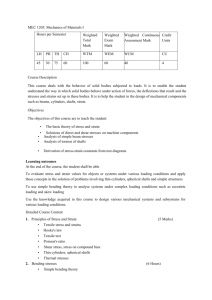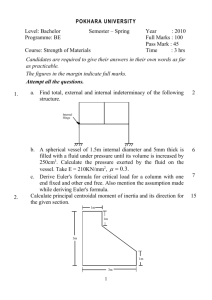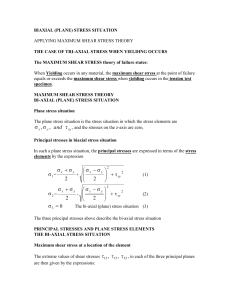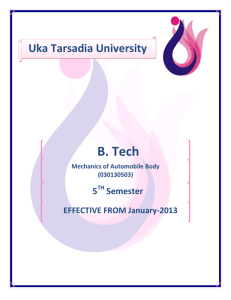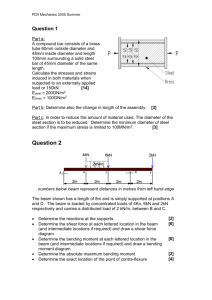ME16A: CHAPTER 6
advertisement
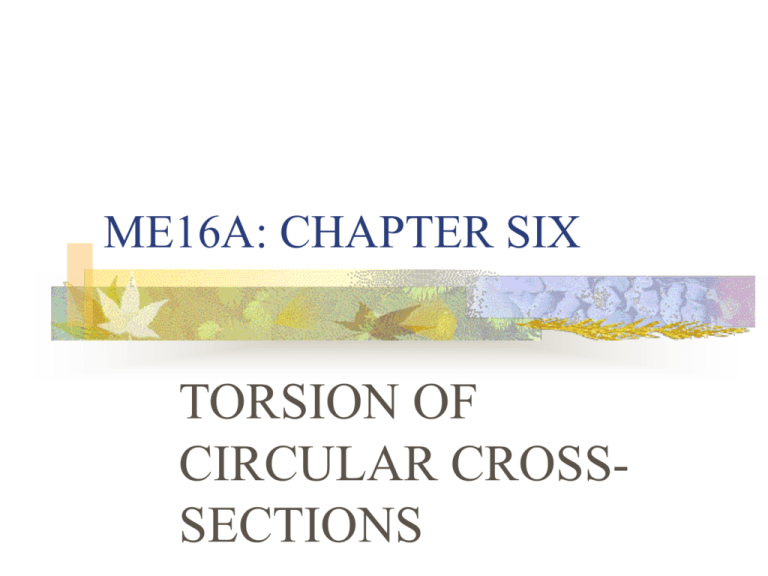
ME16A: CHAPTER SIX TORSION OF CIRCULAR CROSSSECTIONS 6.1. SIMPLE TORSION THEORY When a uniform circular shaft is subjected to a torque, it can be shown that every section of the shaft is subjected to a state of pure shear (Fig. 6.1), the moment of resistance developed by the shear stresses being everywhere equal to the magnitude, and opposite in sense, to the applied torque. For the purposes of deriving a simple theory to describe the behaviour of shafts subjected to torque it is necessary to make the following basic assumptions: Shear System Set Up on an Element in the Surface of a Shaft Subjected to Torsion Resisting torque, T Applied torque T Assumptions (1) The material is homogeneous, i.e. of uniform elastic properties throughout. (2) The material is elastic, following Hooke's law with shear stress proportional to shear strain. (3) The stress does not exceed the elastic limit or limit of proportionality. (4) Circular sections remain circular. Assumptions Contd. (5) Cross-sections remain plane. (This is certainly not the case with the torsion of non-circular sections.) (6) Cross-sections rotate as if rigid, i.e. every diameter rotates through the same angle. Practical tests carried out on circular shafts have shown that the theory developed below on the basis of these assumptions shows excellent correlation with experimental results. (a) Angle of Twist Consider now the solid circular shaft of radius R subjected to a torque T at one end, t other end being fixed (Fig. 6.2). Under the action of this torque a radial line at the free end the shaft twists through an angle , point A moves to B, and AB subtends an angle at' fixed end. This is then the angle of distortion of the shaft, i.e. the shear strain. Since: angle in radians = arc /radius arc AB = R = L = R /L From the definition of rigidity modulus: G shear stress shear strain (1) Simple Torsion Theory Contd. = /G (2) where is the shear stress set up at radius R. Therefore equating eqns. (1) and (2), R L G R where F IJ ………………. G HK G ' L r ’ is the shear stress at any other radius r. (3) (b) Stresses Let the cross-section of the shaft be considered as divided into elements of radius r and thickness dr as shown in Fig. 6.3 each subjected to a shear stress ’ Fig. 6.3. Shaft cross-section. The force set up on each element = stress x area = ’ x 2 r dr (approximately) This force will produce a moment about the center axis of the shaft, providing a contribution to the torque: Shear stress ( ’ x 2 = 2 ’ r2 dr z R T r dr) x r 2 ' r2 0 ’ will vary with the radius r and will therefore be replaced in terms of From equation (3) G ' r L z R T 0 2 G 3 r dr L G L 0 2 r 3 dr z R The integral z R 0 2 r 3 dr is called the polar moment of area J, and may be evaluated as a standard form for solid and hollow shafts as shown in the section 6.2 elow. T T J G J L G L …………… (4) Combining equations (3) and (4) produces the so called simple theory of torsion equation: T G J R L ………………. (5) 6.2 POLAR SECOND MOMENT OF AREA As stated above, the polar second moment of area, J is defined as z R J = 0 2 r 3 dr Lr O 2 R 2 MP N4 Q 4 4 For a solid shaft J = R 4 D4 0 (6) 32 For a hollow shaft of internal radius r: z R J = 0 2 r 3 dr = 2 L r O (R M P N4 Q 2 4 R 4 r4 ) r Where D is the external and d is the internal diameter. D c 32 4 d4 h (7) 6.3 Shear Stress and Shear Strain in Shafts The shear stresses developed in a shaft under pure torsion as shown in Fig. 6.1., their values as given by the simple torsion theory as: G R L From the definition of shear or rigidity modulus, G G The two equations can be combined to relate shear stress and strain in the shaft to the angle of twist per unit length thus: G R G L (8) or, in terms of some internal radius, r, ' G r L G (9) These equations indicate that the shear stress and shear strain vary linearly with radius and have their maximum value at the outside radius (Fig. 6.4). The applied shear stresses in the plane of the cross-section are accompanied by complementary stresses of equal value on longitudinal planes as indicated in Figs. 6.1 and 6.4. Complementary longitudinal shears Fig. 6.4. Complementary longitudinal shear stress in a shaft subjected to torsion 8.4 Section Modulus It is sometimes convenient to re-write part of the torsion theory formula to obtain the maximum shear stress in shafts as follows: T J R TR J With R the outside radius of the shaft the above equation yields the greatest value possible for (Fig. 6.4), max TR T J Z (10) where Z = J/R is termed the polar section modulus. From the preceding section: for solid shafts: Z D3 16 and for hollow shafts, Z ( D4 d 4 ) 16 D (11) 6.5 Torsional Rigidity The angle of twist per unit length of shafts is given by the torsion theory as: L T GJ The quantity G J is called the torsional rigidity of the shaft and is thus given as: GJ T /L (12) i.e. the torsional rigidity is the torque divided by the angle of twist (in radians) per unit length. Power Transmitted by Shafts If a shaft carries a torque T Newton-Metre and rotates at w rad/s, it will do work a the rate of T w Nm/s ( or joule/s) Now the rate at which a system works is defined as its power, the basic unit of power being the Watt ( 1 Watt = 1 N m/s). Thus, the power transmitted by the shaft: = T w Watts = 2 N T 60 N = revolutions per minute Since the Watt is a very small unit of power in engineering terms use is normally made of S.I. multiples, i.e. kilowatts (kW) or megawatts (MW). Combined Stress Systems-Combined Bending and Torsion In most practical transmission situations shafts which carry torque are also subjected to bending, if only by virtue of the self-weight of the gears they carry. Many other practical applications occur where bending and torsion arise simultaneously so that this type of loading represents one of the major sources of complex stress situations. Combined Stress Systems Contd. In the case of shafts, bending gives rise to tensile stress on one surface and compressive stress on the opposite surface whilst torsion gives rise to pure shear throughout the shaft. An element on the tensile surface will thus be subjected to the stress system indicated in Fig. 6.5 and equation or the Mohr circle procedure derived in Chapter 4 can be used to obtain the principal stresses present. Combined Bending and TorsionEquivalent Bending Moment For shafts subjected to the simultaneous application of a bending moment M and torque T the principal stresses set up in the shaft can be shown to be equal to those produced by an equivalent bending moment, of a certain value Me acting alone. Combined Bending and TorsionEquivalent Bending Moment Contd. From the simple bending theory the maximum direct stresses set up at the outside surface of the shaft owing to the bending moment M are given by M ymax M D I 2I Similarly, from the torsion theory, the maximum shear stress in the surface of the shaft is given by TR TD J 2J Combined Bending and TorsionEquivalent Bending Moment Contd. But for a circular shaft: J = 2 I, TD 4I The principal stress for this system can now be obtained by applying the formula derived in the last Chapter. 1 2 1 or 2 ( x y ) and with y 1 ( x y ) 2 4 2 2 = 0, the maximum principal stress F IJ G H K 1 MD 1 1 2 2I 2 F IJ M G HK 1 D = 2 2I 1 is given by: F FT D I M DI 4G J G J H2 I K H4 I K 2 (M 2 T2) 2 Combined Bending and Torsion-Equivalent Bending Moment Concluded Now, if Me is the bending moment which acting alone will produce the same maximum stress, then: 1 M e ymax M e D I 2I F I G HJ KM Me D 1 D 2I 2 2I ( M 2 T2) i.e. the equivalent bending moment is given by: Me 1 M 2 ( M 2 T2) (13) and it will produce the same maximum direct stress as the combined bending and torsion effects.

![Applied Strength of Materials [Opens in New Window]](http://s3.studylib.net/store/data/009007576_1-1087675879e3bc9d4b7f82c1627d321d-300x300.png)
